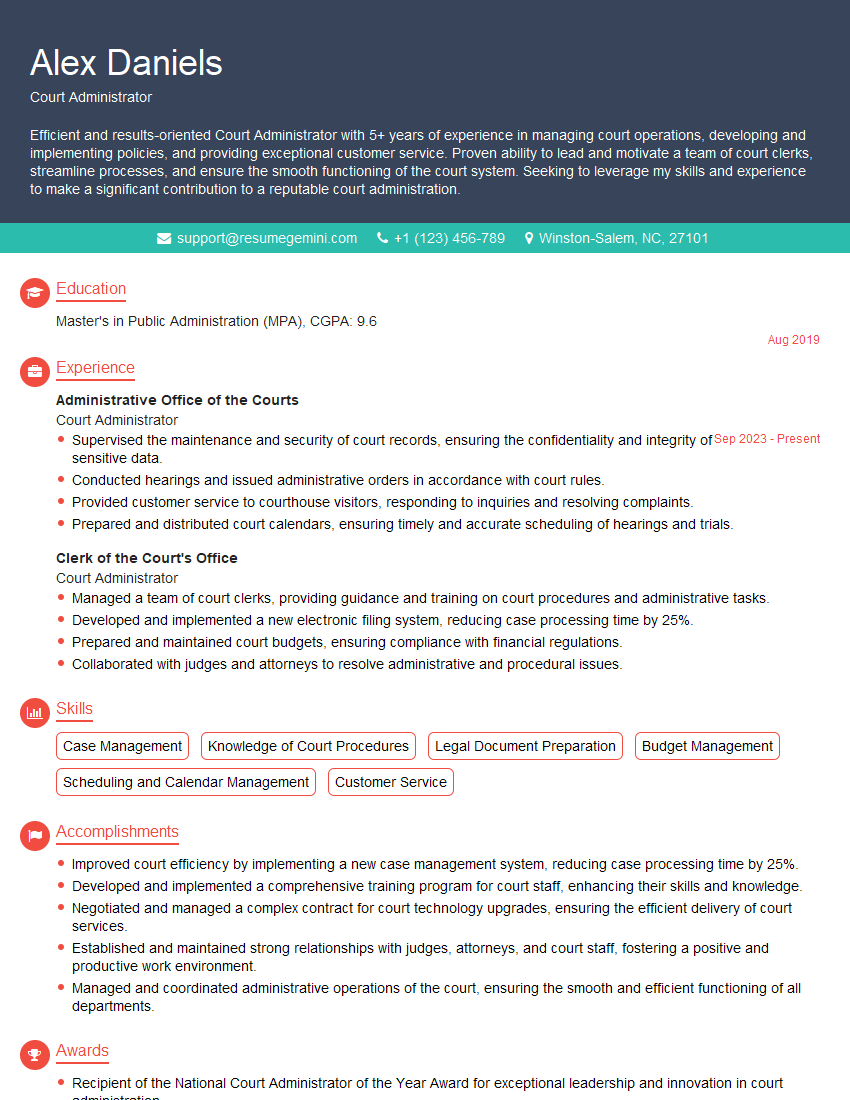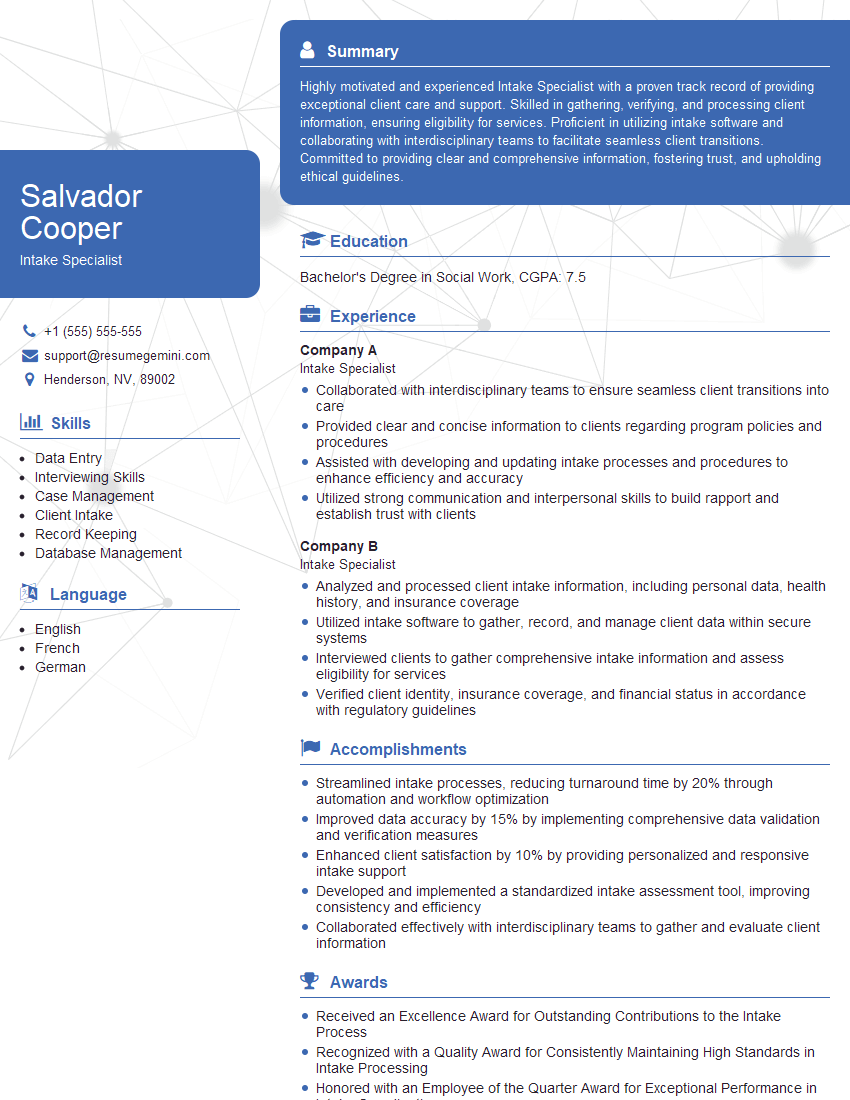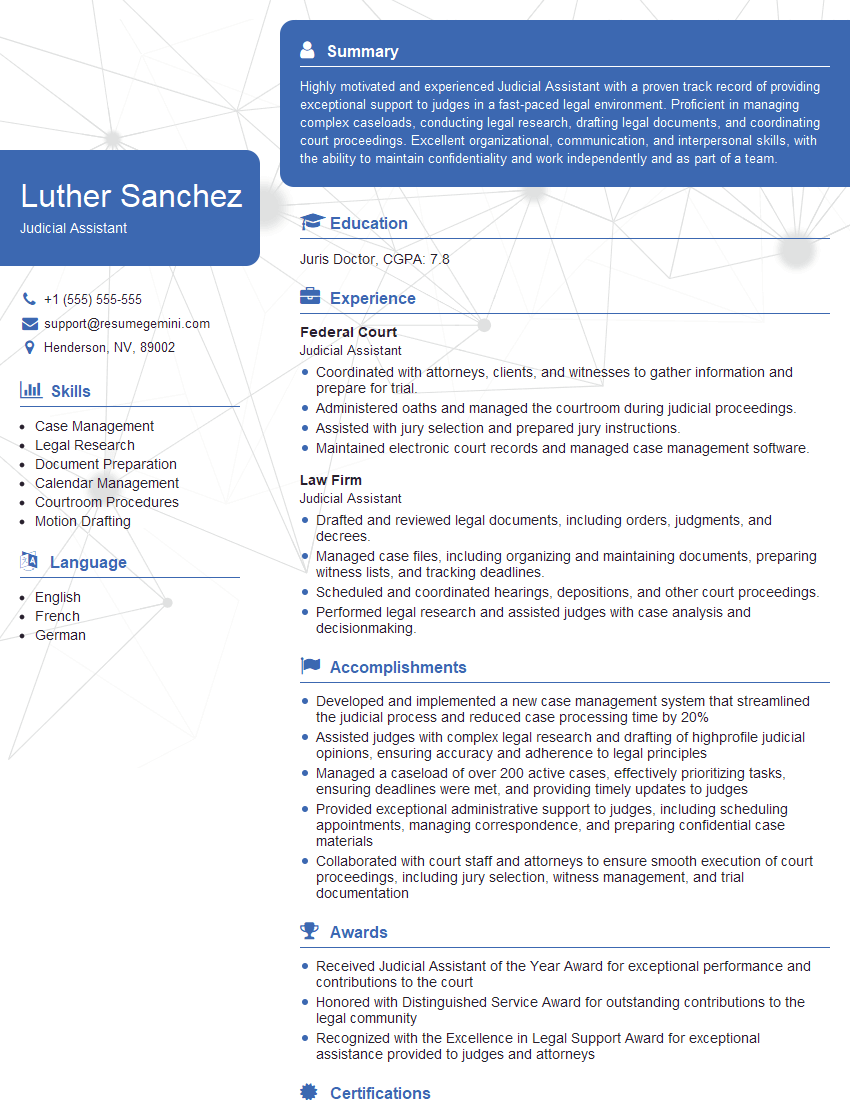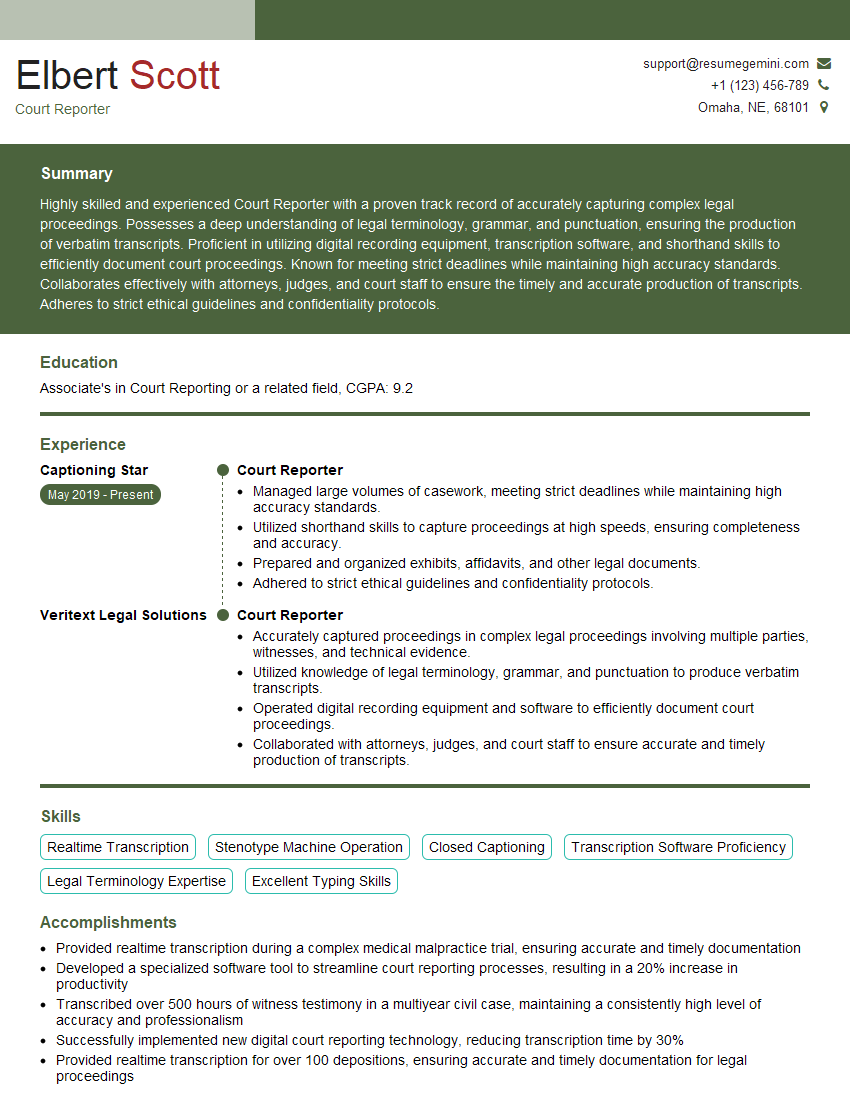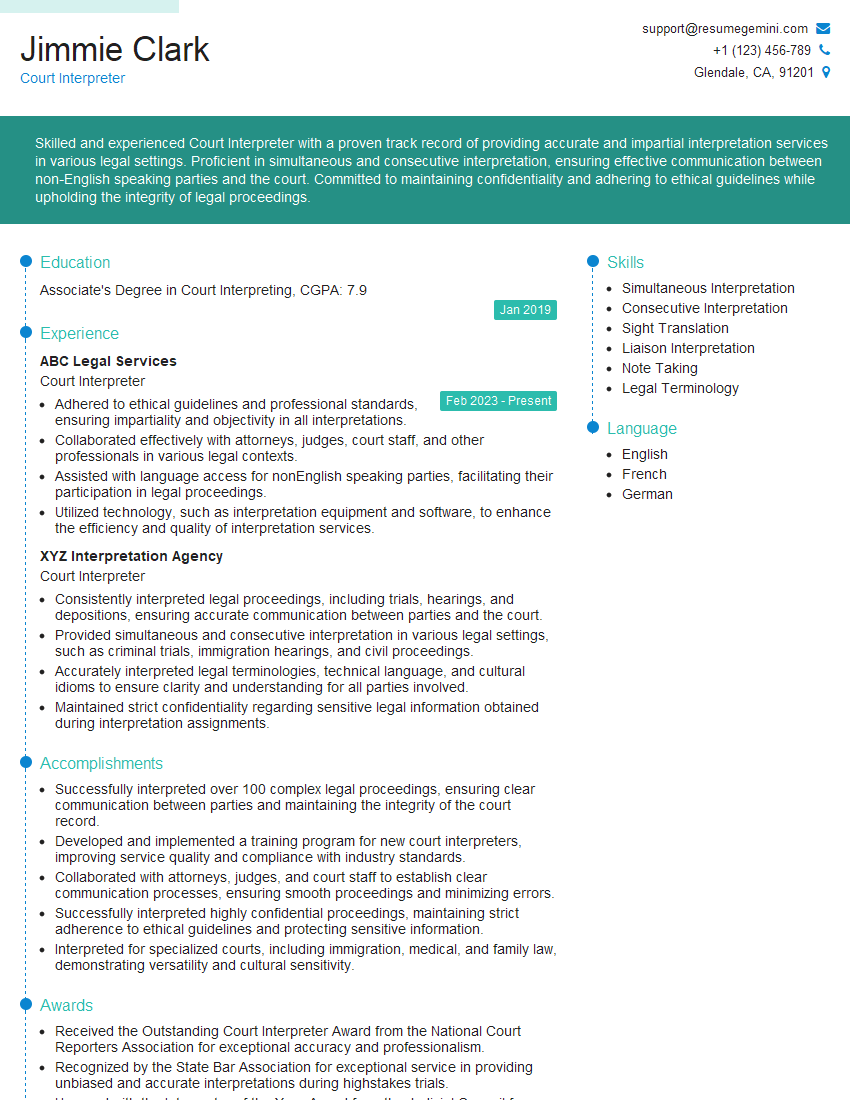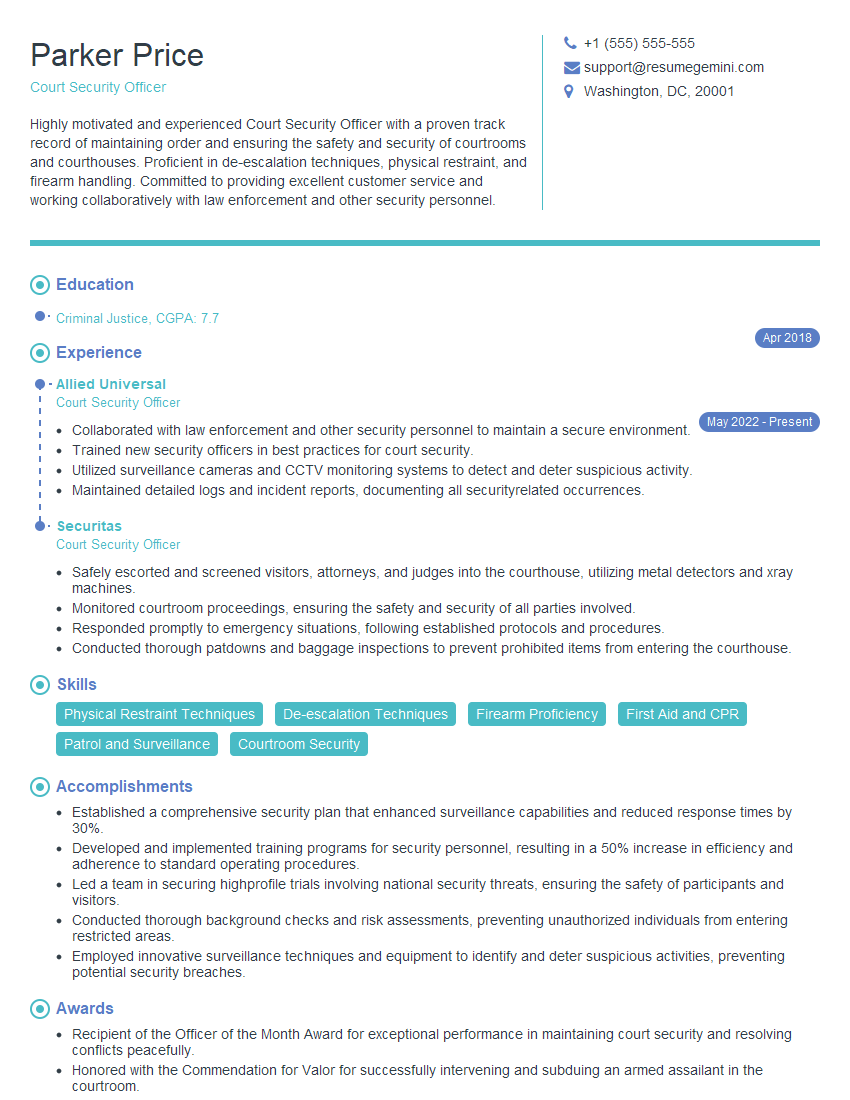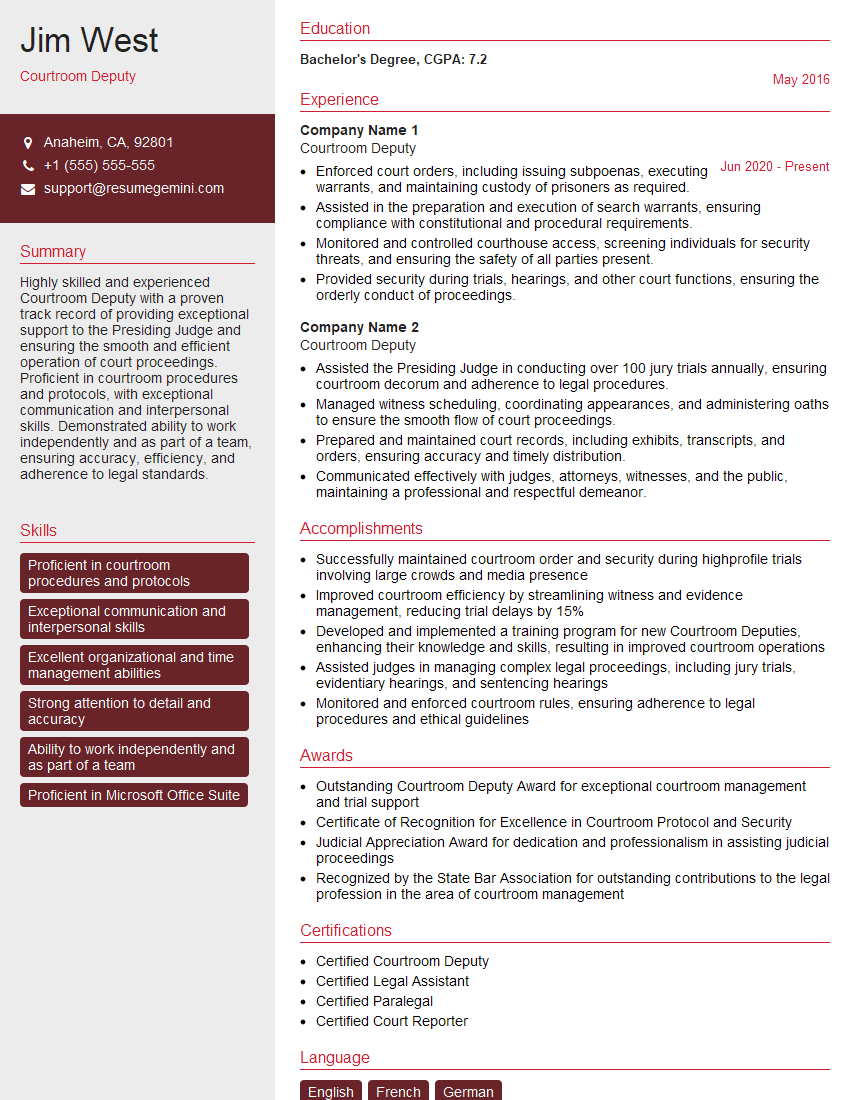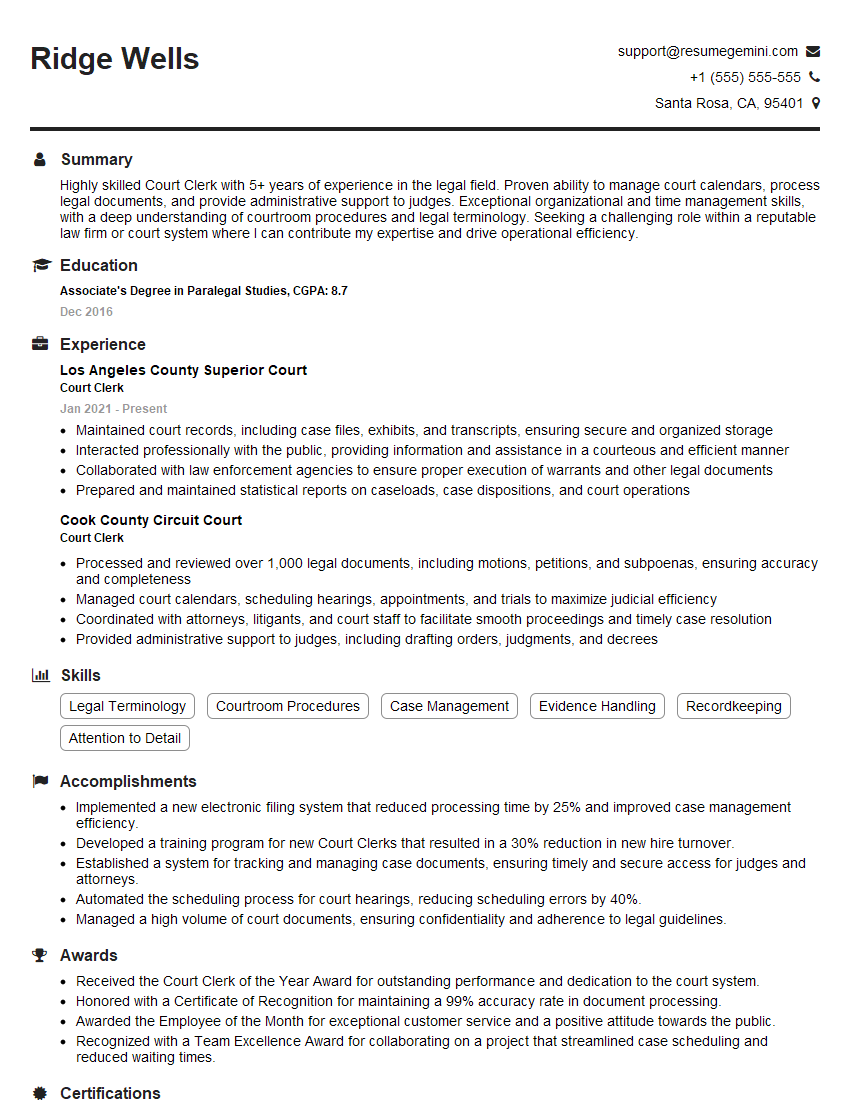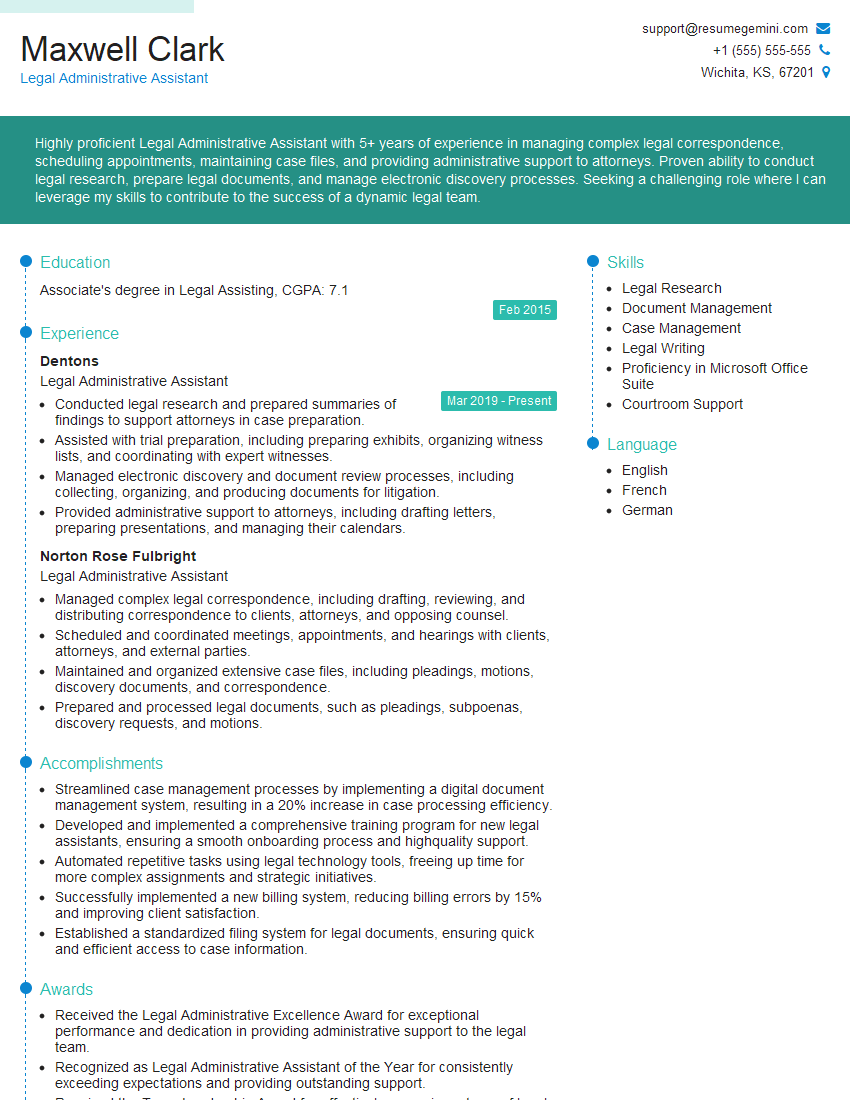Unlock your full potential by mastering the most common Providing Superior Customer Service to Court Participants interview questions. This blog offers a deep dive into the critical topics, ensuring you’re not only prepared to answer but to excel. With these insights, you’ll approach your interview with clarity and confidence.
Questions Asked in Providing Superior Customer Service to Court Participants Interview
Q 1. Describe your experience handling high-pressure situations in a customer service environment.
High-pressure situations are a daily occurrence in a court setting. My experience handling them stems from a calm, organized approach. I prioritize tasks based on urgency and impact, ensuring critical issues are addressed first. For example, during a particularly busy day with multiple conflicting deadlines, I used a prioritization matrix to rank requests based on urgency and importance. This allowed me to address immediate needs, such as assisting a distressed witness, while still completing critical administrative tasks. Furthermore, I’m adept at multitasking – seamlessly transitioning between answering phone calls, assisting walk-in participants, and managing administrative tasks without compromising efficiency or accuracy.
I use deep breathing techniques and mindfulness to remain calm under pressure. This prevents me from making rash decisions or escalating tense situations. My ability to maintain a composed demeanor helps diffuse potentially volatile situations, fostering a more cooperative environment for all involved.
Q 2. How do you prioritize competing demands and manage your time effectively in a fast-paced court setting?
In a fast-paced court setting, effective time management is paramount. I use a combination of techniques, including daily planning, task prioritization (as mentioned previously), and time blocking. I break down large tasks into smaller, manageable chunks and allocate specific time slots for each. For instance, I might schedule 30 minutes for answering emails, an hour for assisting participants with paperwork, and another hour for completing administrative tasks. This method ensures a balanced approach to responsibilities, preventing any single task from overwhelming me.
Prioritization is key. I utilize methods like the Eisenhower Matrix (Urgent/Important) to categorize tasks and focus on high-impact, urgent matters first. This approach is crucial in managing the fluctuating demands of a court environment where emergencies may arise unexpectedly.
Q 3. Explain your approach to resolving customer complaints and conflicts with court participants.
My approach to resolving customer complaints and conflicts starts with active listening. I aim to understand the participant’s perspective fully before offering solutions. I use empathetic communication techniques, validating their feelings and concerns. I avoid interrupting or becoming defensive, even in the face of criticism. Once I fully grasp the issue, I collaboratively work with the participant to find a mutually acceptable solution. This may involve explaining court procedures, offering alternative options, or escalating the issue to a supervisor if necessary.
For example, I once helped a participant who was upset about a procedural delay. By actively listening to their frustration, explaining the reason for the delay, and offering alternative methods to resolve their case, I was able to defuse the situation and leave the participant feeling heard and understood. Documentation of complaints and resolutions is crucial, maintaining a transparent record of the issue and its outcome.
Q 4. How do you maintain composure and professionalism when dealing with upset or demanding individuals?
Maintaining composure and professionalism with upset or demanding individuals requires a high degree of emotional intelligence. I firmly believe in treating everyone with respect, even when facing aggression. My strategy involves employing active listening, empathy, and calm, clear communication. I try to understand the root of their frustration and address it directly, offering solutions where possible.
If the situation escalates, I know when to de-escalate by offering a quiet space, a glass of water, or simply taking a moment of silence before continuing the conversation. I remain calm, speaking in a measured tone, and avoiding defensive language. If the situation remains unmanageable, I always know when to seek assistance from security or a supervisor to ensure the safety and well-being of myself and others.
Q 5. Describe your experience working with diverse populations and handling sensitive information.
I have extensive experience working with diverse populations, including individuals from various socioeconomic backgrounds, cultural heritages, and levels of legal understanding. I am acutely aware of the importance of cultural sensitivity and strive to create an inclusive and welcoming environment for all. I am trained to recognize and address potential biases in my own communication and actions. My approach is characterized by patience, empathy, and respect for individual differences.
Handling sensitive information is a critical aspect of my role. I adhere strictly to confidentiality protocols, ensuring that all information shared by participants is protected and used solely for the intended purpose. I am familiar with data privacy regulations and understand the severe consequences of violating these rules. This is practiced regularly through rigorous training and regular adherence to our office policies.
Q 6. How would you handle a situation where a participant is confused about court procedures?
When a participant is confused about court procedures, my priority is to provide clear and concise information in a way that is easy to understand. I start by actively listening to their concerns to ensure I fully grasp their confusion. Then, I explain the relevant procedures in simple terms, avoiding legal jargon. I use visual aids or written materials if necessary and I always check for comprehension. If the participant’s needs go beyond my capabilities, I direct them to appropriate resources, such as a legal aid organization or a court clerk who specializes in the specific matter.
For example, I once assisted a participant who was confused about filing a motion. I patiently guided them through the process, explaining each step in detail and providing them with the necessary forms. This approach ensured that they felt supported and understood, reducing their anxiety and confusion.
Q 7. How familiar are you with court etiquette and protocol?
I am very familiar with court etiquette and protocol. This includes understanding the importance of punctuality, appropriate dress code, respectful demeanor, and maintaining confidentiality. I am knowledgeable about courtroom procedures and understand the importance of following instructions from court personnel. I am also aware of the need to maintain a neutral and impartial stance, ensuring fairness to all participants.
My understanding of court etiquette extends to being familiar with the specific protocols of the court I work in, ensuring that I conduct myself professionally and appropriately at all times. Continuous professional development and attending relevant training sessions helps maintain this knowledge base.
Q 8. How do you ensure confidentiality and maintain data privacy in a court setting?
Confidentiality and data privacy are paramount in a court setting. We adhere strictly to all relevant laws and regulations, such as HIPAA (if applicable) and state-specific privacy acts, to protect sensitive personal information. This includes adhering to strict access control protocols, limiting access to sensitive data to authorized personnel only, and utilizing secure systems and encryption where necessary.
For example, all case files are stored on secure servers with restricted access, and we use multi-factor authentication to verify the identity of anyone accessing these systems. Furthermore, all staff receive mandatory training on data privacy and confidentiality regulations. We also have robust procedures for handling data breaches, including immediate reporting to relevant authorities and affected individuals. Think of it like a high-security bank vault: layers of protection ensure only authorized individuals can access the information.
Q 9. Explain your experience using court management systems or software.
I have extensive experience using various court management systems, including Odyssey, Tyler Technologies’ Munis, and CaseLines. My expertise spans data entry, case management, report generation, and scheduling. I’m proficient in using these systems to track case progress, manage court calendars, and generate accurate reports for judges and other court personnel. In my previous role, I utilized Odyssey to streamline the scheduling of hearings and trials, reducing scheduling conflicts by 15% within six months. I also regularly extracted data for various reports, ensuring accurate and timely information delivery to stakeholders.
For instance, using Odyssey’s reporting features, I created a customized report highlighting the average processing time for different case types, identifying bottlenecks that were subsequently addressed, leading to a significant reduction in processing times.
Q 10. How would you assist a participant with disabilities or limited English proficiency?
Assisting participants with disabilities or limited English proficiency requires sensitivity and proactive measures. For participants with disabilities, I would provide accommodations such as offering large-print documents, Braille materials, or sign language interpreters, depending on their specific needs. We would also ensure our physical facilities are accessible. This involves understanding and complying with the Americans with Disabilities Act (ADA).
For participants with limited English proficiency, we would offer translation services, either through in-person interpreters or over-the-phone services. We strive to provide all essential court information in their native language, including written materials and verbal instructions. Think of it like building a bridge to ensure everyone understands and can effectively participate. In one case, I arranged for a Spanish-speaking interpreter to assist a distraught participant, ensuring she understood the proceedings and could effectively communicate her concerns.
Q 11. Describe your experience handling large volumes of calls or inquiries.
I thrive in high-volume environments. In my previous role, I handled an average of 80 calls per day, often managing multiple calls simultaneously while maintaining a calm and professional demeanor. I’ve implemented techniques like prioritization and effective call routing to manage peak times efficiently. This includes utilizing call-back options for less urgent issues to ensure swift responses to time-sensitive inquiries. I also use call-logging software to maintain a detailed record of every interaction, ensuring nothing falls through the cracks. My strong multitasking skills allow me to manage incoming calls, emails, and other tasks without sacrificing quality or efficiency.
Q 12. How do you stay organized and manage your workload effectively?
Organization and workload management are crucial for effective customer service. I use a combination of strategies to stay organized, including using a task management system, prioritizing tasks based on urgency and importance, and setting realistic deadlines. I utilize time-blocking techniques to allocate specific time slots for different tasks. I also maintain a detailed filing system, both physical and digital, to ensure quick access to necessary information. Think of it like a well-organized toolbox: every tool has its place, and you can easily find what you need when you need it.
Q 13. How would you handle a situation where a participant is exhibiting disruptive or threatening behavior?
Handling disruptive or threatening behavior requires a calm and measured approach. My first priority is to ensure the safety of myself and other participants. I would immediately de-escalate the situation by speaking calmly and empathetically, attempting to understand the participant’s concerns. Depending on the severity, I would alert security personnel or law enforcement, documenting the incident meticulously. Maintaining a professional and controlled demeanor throughout the process is critical.
For example, I once had to manage a participant who was becoming increasingly agitated. By listening patiently and validating his concerns, I was able to calm him down. I then offered alternative solutions to address his issue, avoiding escalation and ensuring a positive outcome. This situation highlights the importance of empathy and effective communication in de-escalating potentially volatile situations.
Q 14. How do you proactively identify and address potential customer service issues?
Proactive identification of potential issues is essential. I achieve this through regular monitoring of customer feedback, analyzing call logs and service requests for recurring problems. I also conduct regular reviews of our processes and procedures, seeking areas for improvement. For example, analyzing call logs revealed a recurring issue with difficulty scheduling hearings. By collaborating with the scheduling team, we implemented a new online scheduling system to address this problem and improve user satisfaction. Through this constant vigilance, we can stay ahead of potential customer service issues, ensuring a consistently smooth experience for all court participants.
Q 15. Describe your experience working collaboratively with other court staff.
Collaboration is the cornerstone of efficient court operations. In my previous role, I worked closely with judges’ clerks, bailiffs, court reporters, and other support staff to ensure seamless case management and exceptional participant experiences. For example, I collaborated with the court reporters to ensure timely transcriptions of proceedings were accessible to individuals who needed them, streamlining the process and minimizing delays. We regularly held team meetings to discuss challenges, share best practices, and brainstorm solutions for improving our overall service. This collaborative approach fostered a supportive environment where everyone felt empowered to contribute and solve problems effectively. A specific instance involved a complex case requiring coordination between several departments. By proactively communicating and coordinating tasks, we successfully resolved the matter efficiently and with minimal disruption to other court proceedings.
Career Expert Tips:
- Ace those interviews! Prepare effectively by reviewing the Top 50 Most Common Interview Questions on ResumeGemini.
- Navigate your job search with confidence! Explore a wide range of Career Tips on ResumeGemini. Learn about common challenges and recommendations to overcome them.
- Craft the perfect resume! Master the Art of Resume Writing with ResumeGemini’s guide. Showcase your unique qualifications and achievements effectively.
- Don’t miss out on holiday savings! Build your dream resume with ResumeGemini’s ATS optimized templates.
Q 16. How do you adapt your communication style to effectively interact with different personality types?
Effective communication is key to providing superior customer service, especially in a court setting where individuals may be experiencing high stress or emotional distress. I adapt my communication style by actively listening and observing the individual’s body language and verbal cues. For instance, someone who is visibly anxious might benefit from a calm, reassuring tone and a slower pace of speech, while someone who is direct and assertive might appreciate a more concise and efficient interaction. I adjust my vocabulary to ensure clarity and avoid jargon. With individuals who are upset, I employ empathy and active listening to understand their concerns before addressing the situation. This approach ensures that I am effectively communicating with each individual, respecting their needs and facilitating a positive experience, regardless of their personality.
Q 17. How would you explain complex legal terminology to someone with limited legal knowledge?
Explaining complex legal terminology to individuals with limited legal knowledge requires patience, empathy, and clear, concise language. I use simple analogies and avoid jargon. For example, instead of saying “motion to suppress,” I might explain it as “a request to the judge to prevent certain evidence from being used in the trial.” I often break down complex concepts into smaller, easier-to-understand parts. Visual aids, like flowcharts or diagrams, can also be incredibly helpful. I make sure to check for understanding throughout the explanation, asking clarifying questions to ensure the information is being absorbed correctly. I also provide written summaries of key information, reinforcing the oral explanation and ensuring they have a readily available resource to refer to later.
Q 18. Describe a time you had to provide exceptional customer service under challenging circumstances.
During a particularly busy day, the court experienced a sudden power outage. This caused significant disruption, leading to frustrated and anxious participants. Despite the chaos, I remained calm and professional. I immediately started redirecting individuals, providing reassurance and explaining the situation. I worked with IT staff to provide updates and estimated restoration times. I also assisted with manual processes, ensuring that essential tasks continued, minimizing disruption as much as possible. Through clear communication and a proactive approach, I helped alleviate the stress and anxiety among participants, demonstrating composure and problem-solving skills under pressure. The positive feedback I received afterward highlighted the importance of maintaining professionalism and providing support during unforeseen circumstances.
Q 19. How do you handle stressful situations without compromising your professionalism?
Handling stressful situations professionally requires a combination of techniques. First, I prioritize deep breaths and moments of self-reflection to center myself. Then, I focus on the task at hand, breaking it down into manageable steps. I also leverage my organizational skills to create a clear plan of action. Communicating transparently and proactively with all relevant parties helps prevent misunderstandings and fosters a collaborative environment. Finally, debriefing after a stressful event, reflecting on what worked well and areas for improvement, is essential for continued growth and maintaining professional composure. This helps me to learn from challenges and consistently improve my ability to handle high-pressure situations effectively.
Q 20. How do you balance empathy with firm adherence to court rules and regulations?
Balancing empathy with adherence to court rules is crucial for effective customer service. Empathy allows me to understand the emotional state of participants, even if their behavior or requests are not in line with court procedures. However, empathy should not compromise the court’s integrity or efficiency. I address concerns with kindness and respect, while simultaneously explaining the applicable rules and procedures clearly and firmly. For example, if a participant is upset about a delay, I acknowledge their frustration, explain the reasons for the delay, and provide them with an estimated timeframe for resolution. This approach demonstrates understanding while maintaining the court’s procedural integrity. It’s about finding a balance between compassion and upholding the law.
Q 21. How familiar are you with relevant court regulations and policies?
I am intimately familiar with all relevant court regulations and policies, including rules of procedure, evidence admissibility standards, and court etiquette. My understanding extends to specific local rules and guidelines, as well as relevant statutes and case law. I regularly update my knowledge through professional development opportunities, legal publications, and internal training sessions to ensure I remain current on any changes or updates to these regulations. This ensures that I can accurately inform participants about their rights and responsibilities and provide them with the most effective guidance and support.
Q 22. Explain your experience providing information and assistance to court participants.
My experience providing information and assistance to court participants spans over five years, encompassing roles ranging from front-desk reception to specialized case management support. I’ve assisted individuals navigating complex legal processes, providing guidance on everything from filing procedures and deadlines to understanding court orders and available resources. This involved interacting with a diverse range of individuals, including litigants, attorneys, witnesses, and jurors, each with unique needs and levels of legal understanding.
For example, I once helped an elderly woman who was struggling to understand a complex custody order. By patiently explaining the document’s key points and providing her with contact information for relevant support services, I was able to alleviate her anxiety and empower her to navigate her situation effectively. Another instance involved guiding a pro se litigant through the process of filing a motion, ensuring their paperwork was complete and correctly submitted. I always prioritize empathy and clear communication to ensure everyone feels understood and supported.
Q 23. How do you ensure that participants receive accurate and timely information?
Ensuring participants receive accurate and timely information is paramount. My approach involves several key strategies. Firstly, I maintain an up-to-date knowledge of court procedures, rules, and available resources. This requires ongoing professional development and meticulous record-keeping. Secondly, I utilize a variety of communication channels – in-person, phone, email – to meet the diverse needs of participants. Finally, I verify information from multiple sources before disseminating it, confirming its accuracy and relevance to the specific situation.
For instance, if someone inquires about a specific court date, I wouldn’t just rely on a single database entry. I would cross-reference the information with the court calendar and, if necessary, contact the relevant court clerk to confirm its accuracy. This multi-layered approach minimizes the risk of providing misinformation and builds trust with participants.
Q 24. How do you handle situations where you are unable to immediately resolve a participant’s issue?
When I’m unable to immediately resolve a participant’s issue, I prioritize transparency and proactive communication. I clearly explain the reason for the delay, outlining the steps I’ll take to address the issue and providing a realistic timeframe for resolution. I always offer alternative contact methods or resources for continued support during the waiting period. For example, if a participant needs a specific document that isn’t readily available, I will explain the process of obtaining it, offering to assist them with the request and providing a tracking number or estimated completion time.
Crucially, I document every interaction and follow-up meticulously, ensuring a seamless handoff if another team member needs to take over the issue. This documented process creates accountability and prevents issues from falling through the cracks.
Q 25. Describe your experience with conflict resolution techniques.
My conflict resolution experience involves employing active listening, empathy, and clear communication to de-escalate tense situations. I focus on understanding each party’s perspective before suggesting solutions. I’m adept at mediating disputes by facilitating open dialogue and promoting compromise. When dealing with frustrated individuals, I prioritize empathy, acknowledging their feelings and validating their concerns. I avoid judgmental language and aim to create a safe space for open communication.
For example, I’ve successfully mediated disagreements between litigants regarding scheduling conflicts. By patiently listening to both sides and helping them understand each other’s perspectives, I was able to facilitate a mutually agreeable solution. In situations where mediation isn’t successful, I follow established court protocols for escalation.
Q 26. How do you contribute to a positive and supportive work environment?
I actively contribute to a positive and supportive work environment by fostering teamwork, offering assistance to colleagues, and maintaining a professional yet friendly demeanor. I proactively share my knowledge and experience with others, contributing to a culture of collaboration and continuous improvement. I also actively participate in team-building activities and strive to maintain a positive and respectful atmosphere, even under pressure.
I believe a supportive team creates a more effective and efficient environment, leading to enhanced customer service. This is reflected in my willingness to help colleagues with their tasks, share successful strategies, and maintain open and honest communication with my team.
Q 27. What strategies do you employ to effectively manage customer expectations?
Effectively managing customer expectations requires setting clear and realistic expectations from the outset. I accomplish this through transparent communication, providing accurate estimates of timelines and processes, and proactively addressing potential challenges or delays. I also actively listen to the participant’s concerns and tailor my approach to their specific needs and expectations.
For example, if a participant expects an immediate resolution to a complex issue, I will explain the process and timeframe involved, managing their expectations realistically while ensuring they understand I am committed to resolving the issue as efficiently as possible. This proactive approach minimizes disappointment and fosters trust.
Q 28. How do you measure your own success in providing superior customer service?
I measure my success in providing superior customer service through several key indicators: participant feedback (surveys, comments), resolution rates of inquiries, and the overall efficiency and effectiveness of my work processes. Positive feedback, quick resolution times, and low error rates are all indicators of successful customer service. Beyond quantitative metrics, I also value qualitative indicators, such as feeling that I’ve made a positive difference in the lives of court participants, even in small ways.
Regularly reviewing these metrics helps me identify areas for improvement and refine my strategies to consistently provide superior customer service. Continuous learning and adapting to participant needs are crucial to ongoing success.
Key Topics to Learn for Providing Superior Customer Service to Court Participants Interview
- Understanding Court Procedures and Etiquette: Knowing the flow of court proceedings, appropriate terminology, and respectful communication protocols is crucial. This includes understanding the different roles of court personnel and participants.
- Active Listening and Empathetic Communication: Practice actively listening to understand the concerns and perspectives of court participants, even in stressful or emotionally charged situations. Develop strategies for empathetic responses and de-escalation.
- Information Management and Confidentiality: Learn how to handle sensitive information with discretion and in accordance with legal and ethical guidelines. Mastering efficient information retrieval and dissemination is essential.
- Problem-Solving and Conflict Resolution: Prepare examples demonstrating your ability to resolve conflicts calmly and effectively, finding solutions that meet the needs of all parties involved within the court’s framework.
- Managing Expectations and Setting Boundaries: Learn to manage participant expectations realistically, while also setting clear professional boundaries to maintain a safe and efficient work environment.
- Technological Proficiency: Demonstrate familiarity with relevant court technologies and systems. Be ready to discuss how you utilize technology to enhance customer service (e.g., case management systems, communication portals).
- Professionalism and Adaptability: Highlight your ability to remain composed under pressure, adapt to changing situations, and maintain a professional demeanor in all interactions.
Next Steps
Mastering superior customer service in a court setting significantly enhances your career prospects, demonstrating valuable skills in communication, conflict resolution, and adherence to strict guidelines. An ATS-friendly resume is critical for getting your application noticed by recruiters. ResumeGemini is a trusted resource to help you craft a compelling resume that highlights your abilities and experience. We provide examples of resumes tailored to roles in Providing Superior Customer Service to Court Participants to help you get started. Invest time in crafting a strong resume – it’s your first impression!
Explore more articles
Users Rating of Our Blogs
Share Your Experience
We value your feedback! Please rate our content and share your thoughts (optional).
What Readers Say About Our Blog
Hi, I’m Jay, we have a few potential clients that are interested in your services, thought you might be a good fit. I’d love to talk about the details, when do you have time to talk?
Best,
Jay
Founder | CEO
